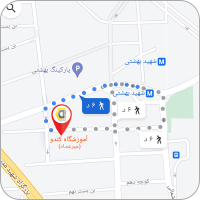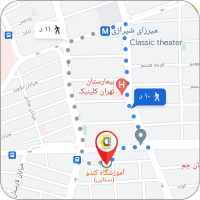الان اینجا هستید:

دوره CCNA 200-301
- نوع دوره: حضوری و آنلاین
- تقویم برگزاری دوره
۲۰٪ تخفیف دوره آنلاین
زمانی دیگر؟
اگر زمان برگزاری این دوره برای شما مناسب نیست، زمان موردنظر خودتون رو از ما درخواست کنید
- چرا کندو؟

ضبط تصویری

دسترسی ریموت

ضمانت شغل
- معرفی این دوره
مدرک CCNA که اولين دوره و در واقع پيش نياز ساير مدارک CISCO است شامل اطلاعات پايهاي در مورد شبکه WAN, LAN و نحوهي نصب و راهاندازي اين نوع شبکهها تا سطح کوچک (زير يکصد کامپيوتر در شبکه) ميباشد. در دوره CCNA مفاهيم سوئيچينگ و روتينگ و همچنين نحوه نصب و راه اندازي سوئيچها و روترهاي CISCO در لايههاي دوم و سوم شبکه مورد بررسي قرار ميگيرند. ضمن اينکه پروتکلهاي ارتباطي شبکه هم تا سطح بالاتري نسبت به مدرک + NETWORK آموزش داده ميشود. آموزشگاه کندو کسب اين مدرک را به کساني که قصد دارند به عنوان دستيار يا همکار با متخصصان شبکه در نصب و راه اندازي و رفع عيب شبکه استخدام شوند توصيه مينمايد. طبق آخرين آمار از مجله Forbes و موسسه بين المللي Global Knowledge در آمد متوسط ساليانه افراد دارنده مدرک CCNA ، حدوداً 80 هزار دلار است.
- مدرک پایان دوره
- کندو معتبرترین آموزشگاه IT ایران است که بیشترین فارغالتحصیلان را دارد.
- بسیاری از مدیران صنعت IT ایران در آموزشگاه کندو دوره دیدهاند.
- بسیاری از فارغ التحصیلان آموزشگاه کندو خارج از ایران مشغول به کار شدهاند.
- مدرک کندو قابلیت ترجمه و استفاده برای امور مهاجرتی را نیز دارد.
- مدارک دورههای حضوری و آنلاین هیچ تفاوتی با هم ندارند.
نمونه مدارک:
- اهداف و دستاوردها
- شناسایی اجزای تشکیل دهنده یک شبکه رایانه ای و توصیف خصوصیات اساسی آنها
- درک مدل ارتباط بین میزبان ها (host-to-host communication)
- توصیف ویژگی ها و عملکردهای نرم افزار Cisco Internetwork Operating System (IOS®)
- توصیف شبکه های محلی (LAN) ها و نقش سوئیچ ها
- توصیف اترنت به عنوان لایه دسترسی شبکه TCP / IP و عملکرد سوئیچ ها
- نصب سوئیچ و پیکربندی اولیه آن
- توصیف لایه اینترنت TCP / IP ، IPv4 ، طرح آدرس دهی و زیر شبکه
- توصیف لایه TCP / IP Transport و Application
- شناخت عملکردهای مسیریابی
- پیکربندی اساسی روترهای سیسکو
- توصیف ارتباطات بین میزبان ها از طریق سوئیچ ها و روترها
- شناسایی و برطرف کردن مسائل مشترک شبکه سوئیچ شده و مشکلات رایج مرتبط با آدرس دهی IPv4
- توصیف ویژگی ها و آدرس های اصلی IPv6 ، پیکربندی و تایید اتصال اولیه IPv6
- توصیف عملکرد ، مزایا و محدودیت های مسیریابی ثابت
- توصیف ، پیاده سازی و تأیید شبکه های محلی مجازی (VLAN) و Trunk ها
- توصیف برنامه و پیکربندی مسیریابی بین VLAN ها
- توصیف اصول پروتکل های مسیریابی دینامیک و جزئیات کامل پروتکل مسیریابی Open Short Short Path First (OSPF)
- نحوه عملکرد پروتکل های Spanning Tree (STP) و Rapid Spanning Tree Protocol (RSTP)
- پیکربندی لینک های aggregation با استفاده از پروتکل EtherChannel
- توصیف هدف از پروتکل های افزونگی لایه 3
- توصیف مفاهیم اساسی WAN و VPN
- توصیف عملکرد لیست های کنترل دسترسی (ACL) و برنامه های آنها در شبکه
- پیکربندی دسترسی به اینترنت با استفاده از سرویس گیرنده های پروتکل پیکربندی میزبان پویا (DHCP) و توضیح و پیکربندی ترجمه آدرس شبکه (NAT) در روترهای سیسکو
- توصیف مفاهیم اولیه کیفیت خدمات (QoS)
- توصیف مفاهیم شبکه های بی سیم ، انواع شبکه های بی سیم قابل ساخت و نحوه استفاده از کنترل کننده های شبکه بی سیم (WLC)
- توصیف معماری شبکه و دستگاه و معرفی مجازی سازی
- معرفی مفهوم قابلیت برنامه نویسی شبکه و شبکه تعریف شده توسط نرم افزار (SDN) و توصیف راه حل های مدیریت شبکه هوشمند مانند Cisco DNA Center ™ ، Access-Defined Defined (SD-Access) ، و Software-Defined Wide Area Network (SD-WAN)
- پیکربندی ابزارهای اصلی نظارت بر سیستم IOS
- توصیف مدیریت دستگاه های سیسکو
- توصیف تهدیدات امنیتی موجود
- توصیف فن آوری های دفاع در برابر تهدیدهای موجود
- پیکربندی امنیتی اصلی صفحه مدیریت دستگاه
- اجرای مراحل لازم برای ایمن سازی تجهیزات شبکه
- امکانات و فضای آموزشگاه
- لابراتوار تجهیز شده ۲۴ ساعته و رایگان
- سیستم و اینترنت پرسرعت + فیلترشکن
- ضبط محتوای کلاس و دسترسی دائم به آن
- کافه + امکانات پذیرایی بین کلاس
- فوتبال دستی و پینگ پنگ
- فضای سبز تجهیز شده
دو آموزشگاه در تهران:
- ساختمان میرعماد: خیابان مطهری، خیابان میرعماد، کوچه جنتی ۱۳، پلاک ۳۰ (فاصله تا متروی بهشتی ۵ دقیقه پیاده)
- ساختمان سنایی: خیابان سنایی، تقاطع خیابان مطهری، کوچه ۲۱، پلاک ۲ (فاصله تا متروی میرزای شیرازی ۱۰ دقیقه پیاده و ایستگاه BRT ولیعصر ۱۰ دقیقه)
مسیریابی از روی گوگلمپ:
- سرفصل های CCNA 200-301
1.0 Network Fundamentals
1.1 Explain the role and function of network components
1.1.a Routers
1.1.b L2 and L3 switches
1.1.c Next-generation firewalls and IPS
1.1.d Access points
1.1.e Controllers (Cisco DNA Center and WLC)
1.1.f Endpoints
1.1.g Servers
1.2 Describe characteristics of network topology architectures
1.2.a 2 tier
1.2.b 3 tier
1.2.c Spine-leaf
1.2.d WAN
1.2.e Small office/home office (SOHO)
1.2.f On-premises and cloud
1.3 Compare physical interface and cabling types
1.3.a Single-mode fiber, multimode fiber, copper
1.3.b Connections (Ethernet shared media and point-to-point)
1.3.c Concepts of PoE
1.4 Identify interface and cable issues (collisions, errors, mismatch duplex, and/or speed)
1.5 Compare TCP to UDP
1.6 Configure and verify IPv4 addressing and subnetting
1.7 Describe the need for private IPv4 addressing
1.8 Configure and verify IPv6 addressing and prefix
1.9 Compare IPv6 address types
1.9.a Global unicast
1.9.b Unique local
1.9.c Link local
1.9.d Anycast
1.9.e Multicast
1.9.f Modified EUI 64
1.10 Verify IP parameters for Client OS (Windows, Mac OS, Linux)
1.11 Describe wireless principles 1.11.a Nonoverlapping Wi-Fi channels 1.11.b SSID 1.11.c RF 1.11.d Encryption
1.12 Explain virtualization fundamentals (virtual machines)
1.13 Describe switching concepts
1.13.a MAC learning and aging
1.13.b Frame switching
1.13.c Frame flooding
1.13.d MAC address table
2.0 Network Access
2.1 Configure and verify VLANs (normal range) spanning multiple switches
2.1.a Access ports (data and voice)
2.1.b Default VLAN
2.1.c Connectivity
2.2 Configure and verify interswitch connectivity
2.2.a Trunk ports
2.2.b 802.1Q
2.2.c Native VLAN
2.3 Configure and verify Layer 2 discovery protocols (Cisco Discovery Protocol and LLDP)
2.4 Configure and verify (Layer 2/Layer 3) EtherChannel (LACP)
2.5 Describe the need for and basic operations of Rapid PVST+ Spanning Tree Protocol and identify basic operations
2.5.a Root port, root bridge (primary/secondary), and other port names
2.5.b Port states (forwarding/blocking)
2.5.c PortFast benefits
2.6 Compare Cisco Wireless Architectures and AP modes
2.7 Describe physical infrastructure connections of WLAN components (AP, WLC, access/trunk ports, and LAG)
2.8 Describe AP and WLC management access connections (Telnet, SSH, HTTP, HTTPS, console, and TACACS+/RADIUS)
2.9 Configure the components of a wireless LAN access for client connectivity using GUI only such as WLAN creation, security settings, QoS profiles, and advanced WLAN settings
3.0 IP Connectivity
3.1 Interpret the components of routing table
3.1.a Routing protocol code
3.1.b Prefix
3.1.c Network mask
3.1.d Next hop
3.1.e Administrative distance
3.1.f Metric
3.1.g Gateway of last resort
3.2 Determine how a router makes a forwarding decision by default
3.2.a Longest match
3.2.b Administrative distance
3.2.c Routing protocol metric
3.3 Configure and verify IPv4 and IPv6 static routing
3.3.a Default route
3.3.b Network route
3.3.c Host route
3.3.d Floating static
3.4 Configure and verify single area OSPFv2
3.4.a Neighbor adjacencies
3.4.b Point-to-point
3.4.c Broadcast (DR/BDR selection)
3.4.d Router ID
3.5 Describe the purpose of first hop redundancy protocol
4.0 IP Services
4.1 Configure and verify inside source NAT using static and pools
4.2 Configure and verify NTP operating in a client and server mode
4.3 Explain the role of DHCP and DNS within the network
4.4 Explain the function of SNMP in network operations
4.5 Describe the use of syslog features including facilities and levels
4.6 Configure and verify DHCP client and relay
4.7 Explain the forwarding per-hop behavior (PHB) for QoS such as classification, marking, queuing, congestion, policing, shaping
4.8 Configure network devices for remote access using SSH
4.9 Describe the capabilities and function of TFTP/FTP in the network
5.0 Security Fundamentals
5.1 Define key security concepts (threats, vulnerabilities, exploits, and mitigation techniques)
5.2 Describe security program elements (user awareness, training, and physical access control)
5.3 Configure device access control using local passwords
5.4 Describe security password policies elements, such as management, complexity, and password alternatives (multifactor authentication, certificates, and biometrics)
5.5 Describe remote access and site-to-site VPNs
5.6 Configure and verify access control lists
5.7 Configure Layer 2 security features (DHCP snooping, dynamic ARP inspection, and port security)
5.8 Differentiate authentication, authorization, and accounting concepts
5.9 Describe wireless security protocols (WPA, WPA2, and WPA3)
5.10 Configure WLAN using WPA2 PSK using the GUI
6.0 Automation and Programmability
6.1 Explain how automation impacts network management
6.2 Compare traditional networks with controller-based networking
6.3 Describe controller-based and software defined architectures (overlay, underlay, and fabric)
6.3.a Separation of control plane and data plane
6.3.b North-bound and south-bound APIs
6.4 Compare traditional campus device management with Cisco DNA Center enabled device management
6.5 Describe characteristics of REST-based APIs (CRUD, HTTP verbs, and data encoding)
6.6 Recognize the capabilities of configuration management mechanisms Puppet, Chef, and Ansible
6.7 Interpret JSON encoded data
- داشجویان کندو مشغول به کار شدن در...

فناوری اطلاعات شاتل

شرکت عالیفرد سنایچ

بانک پاسارگاد

بانک ملت

شرکت ارتباطات آسیاتک

پیشگامان توسعه ارتباطات

ایران خودرو

بانک خاورمیانه

ماموت خودرو

پارس خودرو
- اساتید این دوره
- نمونه تدریس
- نظرات شما






